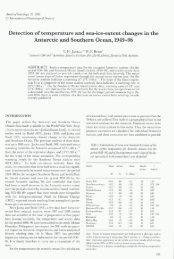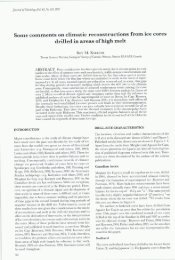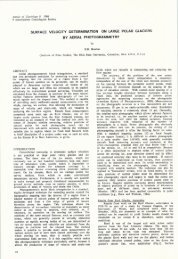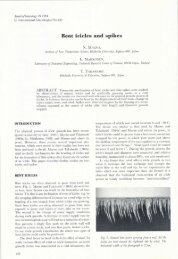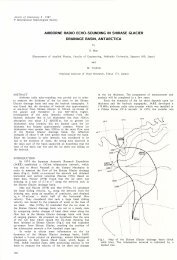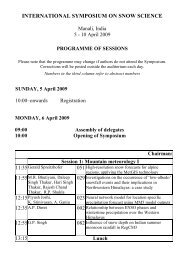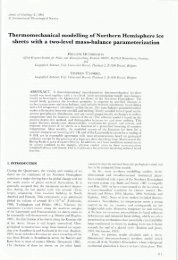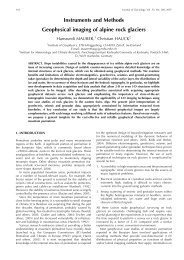143-156 - International Glaciological Society
143-156 - International Glaciological Society
143-156 - International Glaciological Society
Create successful ePaper yourself
Turn your PDF publications into a flip-book with our unique Google optimized e-Paper software.
SIM ULATED GLACIER SLIDING 151<br />
In Experiment B, when passing over the first three-quarters of a bump, the clear frame<br />
(Fig. 6) was deformed by 0.125 rad. When passing over the second half of an obstacle, the<br />
dotted frame was deformed by 0.065 rad. Thus, on this occasion, the deformation went on<br />
in the same direction over the down-stream side of the obstacle. Over the whole bump it<br />
was about 0.16 rad instead ofo.29 rad as in Experiment A. Rotation was negligible in B.<br />
Explanation of the results<br />
The only simple analytical solution with which these results may be compared is that for<br />
the case of no cavitation, infinitesimal slopes, and Newtonian viscous ice. These assumptions<br />
are so far from the truth that we may assume without inconvenience that the ice slides over a<br />
sine curve z = a cos wx from x = - CA) to + 00 instead of considering circular sliding where<br />
r = ro+a cos we. It can be shown that the variations in pressure over the driving cogs<br />
(wz = 1.4) are 3.019 times larger than for a semi-infinite solid (Appendix). On the bumps<br />
(z = 0) the pressure variations are 2.443 times larger, the same applies for the drag which is<br />
Tb = 2-4431)Ua2w3.<br />
The frames were put midway between the cogs and the bumps (wz = 0.7). If cavitation<br />
does not occur in the Newtonian-viscous case, the total rotations on the up-stream side of a<br />
bump should be n = -0.008 rad and the shear deformation €xz should equal -0.072.<br />
This is not the case in our experiments, because the general shear caused by the drag has been<br />
ignored. This shear for a full wavelength is<br />
Yb = 2·443Ua2wlT = 2·443a2w3,\<br />
= 2.443 X 2'TTa2w2 = 0.443 6.<br />
The experiments show that, in the case of cavitation, most of this shear concentrates over<br />
the area where ice and bedrock are in contact, the more so as the sliding velocity increases.<br />
Much more precise numerical computations are in progress, using the finite-difference<br />
method and the finite-element method. They will be published elsewhere.<br />
A more accurate technique for the measurement of strain<br />
In order to measure the normal strains as well as the angular deformations, small plastic<br />
markers were put within the ice, along different radii, numbered 0 to 19. One layer] was<br />
5 cm from the lower side, another layer R at 4 cm from the upper side. Their motion was<br />
identical, indicating that the flow was effectively two-dimensional. Only a fe w marker<br />
positions are indicated on Figure 8. In this figure, A indicates the starting point and 0 the<br />
10<br />
-<br />
12 I 13<br />
8 17<br />
7<br />
Fig. 8. Motion of marks during the January 1973 experiment.<br />
15<br />
0<br />
16<br />
19<br />
18




